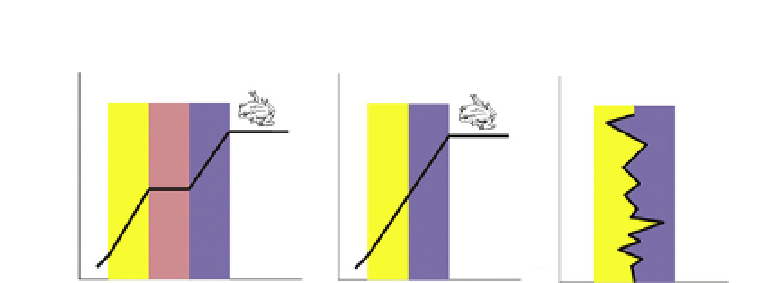Biology Reference
In-Depth Information
A
B
C
E
LM
EM
E
M
Limb
Egg tooth
Time
Time
Time
Figure 9.4 Larval deletion in the evolution of direct development. (A) In the typical
biphasic frog life history with a tadpole, there is a rapid change of morphology in
the development from egg to embryo (E). Once the tadpole larva (L) is produced, its
morphology remains relatively constant while it eats and grows. During metamorphosis
(M) induced by thyroid hormone, the morphology of the tadpole undergoes tremen-
dous change to produce the frog. (B) In the direct developer, the larval period is reduced
until it is essentially gone. That loss fuses the morphological changes of the embryonic
period (E) to those of metamorphosis (M). The fusion line is around TS10 of E. coqui de-
velopment (
Callery & Elinson, 2000b
). (C) The fusion between the embryonic and meta-
morphic periods is not completely smooth. For example, limbs are prominent in the
embryonic period, well before thyroid hormone induced changes. Conversely, the
egg tooth appears after TS10, while the homologous tadpole teeth and beak develop
in the embryonic period. From
Callery et al. (2001)
.
Meckel's cartilage, loss of branchial arch cartilages, enlargement of limb
buds, thickening of the intestinal lining, and a decrease of tail musculature
(
Huang, Marsh-Armstrong, & Brown, 1999; Schreiber, Das, Huang,
Marsh-Armstrong, & Brown, 2001
). They end up as abnormal tadpoles,
however, and do not acquire the morphology of a frog.
The disorganized response is due to differences in tissue sensitivity to thy-
roid hormone, and this sensitivity changes over time (
Buchholz, Moskalik,
Kulkarni, Hollar, & Ng, 2011
). Only by the careful treatment with increasing
amounts of thyroid hormone has a semblance of normal metamorphosis been
achieved precociously (
Etkin, 1935; Kollros, 1961
). An evolutionary move-
ment of thyroid gland activation earlier in development would require con-
comitant changes in tissue sensitivity in order to elicit a proper tissue response.
Perhaps these parallel changes can be coordinated by CRF and CORT.
Hypothalamic CRF stimulates both the thyroid and the interrenal glands,
which in turn synthesize thyroid hormone and CORT (
Denver, 2009
).
CORT affects peripheral tissues in ways that enhance their response to thyroid
hormone (
Bonett et al., 2010; Kikuyama, Kawamura, Tanaka, & Yamamoto,
1993
). Acting synergistically with thyroid hormone, CORT upregulates
the expression of both
thrb
and
type II deiodinase
(
D2
)(
Bonett et al., 2010
).

